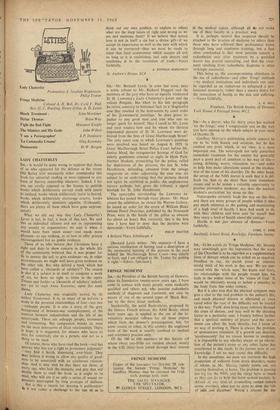SIR,—Mr. Bernard Levin, In your last issue, pays a noble
tribute to Mr. Richard Hoggart and the members of the jury who have so signally vindicated D. H. Lawrence's Lady Chatterley's Lover and the valiant Penguin. But when in his last paragraph he refers, contrary to historical fact, to a 'disgraceful case that resulted in the destruction by court order of his [Lawrence's] paintings,' he does grave in- justice to one good man and true who can no longer speak for himself. May I recall to Mr. Levin and your readers how and by whom the thirteen impounded pictures of D. H. Lawrence were de- livered from the tires of Great Marlborough Street? The only court case in which Lawrence's paintings were involved was heard on August 8, 1929, in Great Marlborough Street Police Court before Mr. Justice Mead, the octogenarian Scourge of God for elderly gentlemen arrested at night in Hyde Park. Herbert Muskctt, prosecuting for the police, called for destruction of the pictures; the late St. John Hutchinson, defending, obtained from the savage magistrate an order adjourning the case sine die subject to an undertaking that the pictures should not again be exhibited in public. An unglamorous victory perhaps; but, given the tribunal, a signal triumph for St. John Hutchinson.
The apocrypha surrounding the Lawrence ex- hibition has passed through many phases: Mr. Mead closed the exhibition; he closed the Warren Gallery; he issued an order for the arrest of William Blake (whose Pencil Drawings, published by the Nonesuch Press, were in the hands of the police as obscene for about an hour). But, curiously, this is the first time 1 have had to deny that the pictures were destroyed.—Yours faithfully, 4 Belford Place, Edinburgh. 4 PHILIP TROTTER [Bernard Levin writes: 'My memory—I have a curious recollection of having read a description of the ceremonial burning of the pictures in the yard behind the Marlborough Street Court—was clearly at fault, and I am obliged to Mr. Trotter for putting it right.'—Editor, Spectator.]














































 Previous page
Previous page